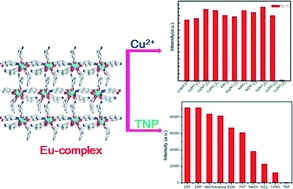2D lanthanide MOFs driven by a rigid 3,5-bis(3-carboxy-phenyl)pyridine building block: solvothermal syntheses, structural features, and photoluminescence and sensing properties†
Abstract
A new series of five lanthanide(III) metal–organic frameworks with a general formula of [Ln3(bcpb)4(μ-HCOO)(μ-H2O)(H2O)2(DEF)]n (1–5) was generated by solvothermal reactions from Ln(NO3)3·6H2O {Ln = Eu (1), Tb (2), Gd (3), Dy (4), and Sm (5)} and 3,5-bis(3-carboxyphenyl)pyridine (H2bcpb) in an aqueous N,N-diethylformamide (DEF) medium. The obtained products were characterized by elemental analysis, FT-IR spectroscopy, thermogravimetric analysis (TGA), and powder and single crystal X-ray diffraction. The latter reveals that all compounds (1–5) are isostructural and feature very intricate 2D metal–organic frameworks. These were topologically analyzed, revealing a very complex hexanodal underlying net that can be simplified further to a binodal 3,5-connected layer with the 3,5L52 topology. Solid-state photoluminescence properties of 1–5 were studied in detail. Compound 1 exhibits a strong red luminescence upon excitation at 338 nm and its lifetime is 532 μs. Compound 2 shows an intense green luminescence upon excitation at 336 and its lifetime is 981 μs. The triplet state (3ππ*) of bcpb2− studied by using the Gd(III) derivative 3 demonstrated that the ligand effectively populates Tb(III) emission (Φ = 70.96%), whereas the corresponding Eu(III) derivative 1 shows a weak luminescence efficiency (Φ = 15.81%) as the triplet state of bcpb2− has a poor match with the 5D0 energy level of Eu(III). A notable feature of 1 is its remarkable sensing ability for Cu2+ ions and 2,4,6-trinitrophenol (TNP). Besides, a series of heterobimetallic Tb-based MOFs, [Tb3(1−x)Eu3x(bcpb)4(μ-HCOO)(μ-H2O)(H2O)2(DEF)]n {x = 0.001, 0.002, 0.003, 0.01, 0.02, 0.03, 0.04, 0.10, 0.15, 0.20} (compounds 2a–2j, respectively), was prepared. The luminescence studies reveal that the simultaneous presence of the characteristic sharp emission bands of Eu3+ and Tb3+ allows the tuning of the photoluminescence colors of such materials by adjusting the doping concentration of the Eu3+ ions.



 Please wait while we load your content...
Please wait while we load your content...